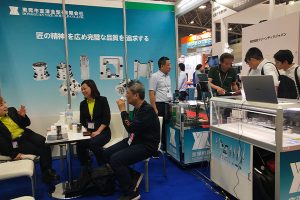Performance of tungsten carbide recycling
The pure tungsten carbide fragments recovered using waste hard alloy anvils are subjected to ball milling and sieving through an 80-mesh (180 μm) screen for particle size composition and distribution […]
The pure tungsten carbide fragments recovered using waste hard alloy anvils are subjected to ball milling and sieving through an 80-mesh (180 μm) screen for particle size composition and distribution analysis, which is then compared with the native tungsten carbide. The recovered tungsten carbide particles are finer, with 59.7% in the range of 1-2 μm, an average particle size of 1.54 μm, and a narrow distribution range, showing a unimodal distribution curve. On the other hand, the native tungsten carbide particles with an average size of 14.2 μm generally exhibit a wider distribution range and a multimodal distribution curve. However, after ball milling, the particle size composition and average particle size of tungsten carbide in the two alloy mixtures become very similar. The former has 83% in the range of 0.5-1.0 μm, with an average particle size of 0.4 μm, while the latter has 81.3% in the range of 0.5-1.0 μm, with an average particle size of 0.41 μm. Both exhibit unimodal distribution curves.
The experiment demonstrates that by controlling the wet milling time and ball-to-material ratio, tungsten carbide particles with different sizes can be adjusted to approximately the same particle size. A comparison of the morphology photos of the two types of tungsten carbide powders reveals significant differences. The recovered tungsten carbide has complete crystalline shapes, predominantly composed of intact individual particles, often in the form of smooth-edged triangular and elongated shapes, with relatively uniform particle distribution. In contrast, the native tungsten carbide consists mostly of irregular large particle aggregates, with unclear interfaces between grains and lacking complete crystalline shapes. Based on the experimental results, it can be concluded that the tungsten carbide grains in waste hard alloys, after electrolytic separation, are preserved intact with a more complete structure (due to the dissolution-precipitation process during sintering), and have fewer internal defects. This characteristic undoubtedly contributes to the production of high-performance mining hard alloys.
Our factory business: carbide parts, mold parts, medical injection molds, precision injection molds, teflon PFA injection molding, PFA tube fittings. email: [email protected],whatsapp:+8613302615729.

The WC-10Co alloy prepared with the recovered tungsten carbide exhibits comparable flexural strength, impact toughness, and resistance to multiple impacts to the native cobalt-containing tungsten carbide alloy. Moreover, there are indications that the fracture toughness of the alloy is slightly superior to that of the native tungsten carbide alloy, which is noteworthy. Wear resistance tests show that the relative wear resistance of the recovered tungsten carbide alloy is slightly higher than that of the native tungsten carbide alloy YG10C (ISO K20).
Through fracture surface observation and comparison, it is found that the types of defects forming fracture initiation sites in the recovered tungsten carbide alloy are mainly porosity and inclusions, which are basically the same as those in the native tungsten carbide alloy YG10C (ISO K20). No fracture initiation sites formed by coarse tungsten carbide or its aggregates are observed. Furthermore, the microstructure of the recovered tungsten carbide alloy exhibits clear grain boundaries, relatively uniform grain distribution, and low interconnectivity, whereas the native tungsten carbide alloy YG10C (ISO K20), apart from containing a small amount of coarse tungsten carbide grains, has blurred grain boundaries, an uneven microstructure, and higher interconnectivity.






